
60年代和70年代最古怪前卫的9大建筑团体
9 of the Most Bizarre and Forward-Thinking Radical Architecture Groups of the 60s and 70s
由专筑网李韧,韩平编译
第一次登陆月球、广泛的反战争运动、伍德斯托克和嬉皮士、农民公社与环保主义、柏林墙以及妇女解放运动,各种事件都发生于六七十年代,这段时间在历史的记忆中难以抹去。伴随着与各种不公正的事件相对抗,并且去推翻现有的各种公约,然而,六七十年底的建筑世界也并没有什么不同。
现代主义者的宏伟愿景受到了来自社会各界的挑战与质疑,尤其是那些六七十年代的“反建筑”或“激进设计派”团体。为了通过建筑的策略作为政治、社会,以及文化批判的方式,他们起草了大胆的宣言,并通过拼贴、音乐、表演艺术、家具、平面设计、杂志、设施、活动、展览的方式来表达设计思路。在这个时代,像Cedric Price、Hans Hollein,和Yona Freidman等人物对当时的社会产生了重大影响,然而,当代的革命精神同样也见证了各种先进小团体的诞生。对于那些标新立异的思维,看一看这些来自六七十年代的那些具有质疑与叛逆精神的建筑团体的名单。
The first moon landing, widespread anti-war protests, Woodstock and the hippies, rural communes and environmentalism, the Berlin Wall, the women’s liberation movement and so much more—the tumultuous decades of the Sixties and Seventies occupy an unforgettable place in history. With injustices openly questioned and radical ideas that set out to unseat existing conventions and practices in various spheres of life, things weren’t any different in the architectural world.
The grand visions dreamt up by the modernists were soon challenged by utopian experiments from the “anti-architecture” or “radical design” groups of the 1960–70s. Reestablishing architecture as an instrument of political, social, and cultural critique, they drafted bold manifestoes and designs, experimented with collage, music, performance art, furniture, graphic design, zines, installations, events, and exhibitions. While certain individuals from this era like Cedric Price, Hans Hollein, and Yona Freidman remain important to the realm of the radical and the unbuilt, the revolutionary spirit of these decades also saw the birth of various young collectives. For eccentricity at its very best, read on for a (by no means exhaustive) list of some groups who dared to question, poke, expand, rebel against, disrupt and redefine architecture in the 60s and 70s.

Image © Ant Farm
Ant Farm(美国 旧金山)
受海湾地区反文化思维的启发,Chip Lord和 Doug Michels于1968年成立了这个建筑团体Ant Farm。该团体的最初目的是改革建筑教育,然而,他们的工作范围则很快扩展到更深层次的批判层面,尤其是路易斯•康和保罗•鲁道夫的粗野主义思潮。他们通过表演、构筑、录像、宣言和各种活动来推广自己的充气建筑,他们偏好于轻巧灵活的设计作品,这些想法最终在当代住宅设计中达到顶峰。
而他们后来的项目,如著名的凯迪拉克牧场秀、Media Burn和海豚大使馆,也以独特的方式对大众消费、生产以及由此造成的环境影响作出评论。然而,好像这一切都无法表达该团体的主要思潮,在当时,他们定制了一辆雪佛兰,这辆车被称为媒体车,陪同他们在美国各地进行旅行与宣讲。
Ant Farm (San Francisco, USA)
Inspired by the counter-culture milieu of the Bay Area, Chip Lord and Doug Michels founded Ant Farm in 1968. While the group’s initial focus was on reforming architectural education, their work soon expanded into a tool for deeper introspection and critique propelled particularly by the Brutalist architecture of Louis Kahn and Paul Rudolph. Through performances, installations, videos, manifestos and agitprop events replete with their own inflatable structures, they celebrated flexibility and lightness; these ideas eventually culminated in the design of The House of the Century.
Subsequent projects, like the famous Cadillac Ranch Show, Media Burn and Dolphin Embassy, also served as a tongue-in-cheek comment on mass consumption, production and the resulting environmental depreciation. As if all this was not enough to satisfy the cheeky spirits of the duo, a customized Chevy called Media Van accompanied them throughout their travels across the United States.
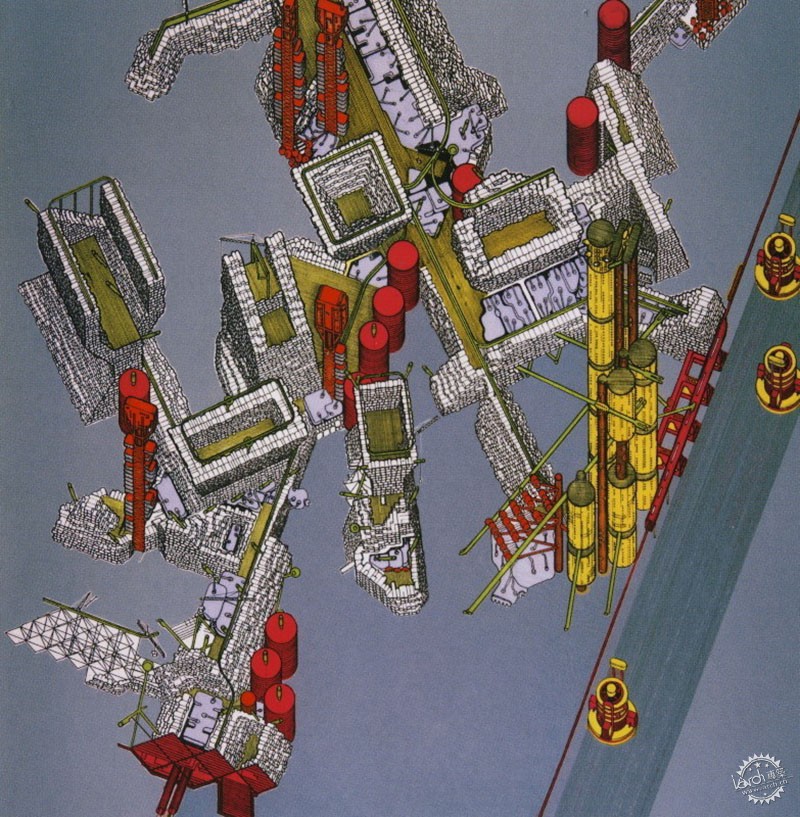
Image © Peter Cook
阿基格拉姆学派(英国)
诸如walk on spindly legs、wearable dwellings、underwater cities、inflatable villages、do-it-yourself building kits等巨型建筑体量,均是阿基格拉姆学派的代表作品,其中的代表人物有Peter Cook、David Greene、Mike Webb、Warren Chalk、Dennis Crompton、Ron Herron,说到这个学派,人们无疑首先向到的是“激进”的“建筑”。
Archigram (UK)
Megastructures that walk on spindly legs, wearable dwellings, underwater cities, inflatable villages, do-it-yourself building kits, pills that induce fantastical architectural visions, and so much more—this group of architects (Peter Cook, David Greene, Mike Webb, Warren Chalk, Dennis Crompton, Ron Herron) is undoubtedly the first that comes to mind when one pairs the word “radical” with “architecture.”
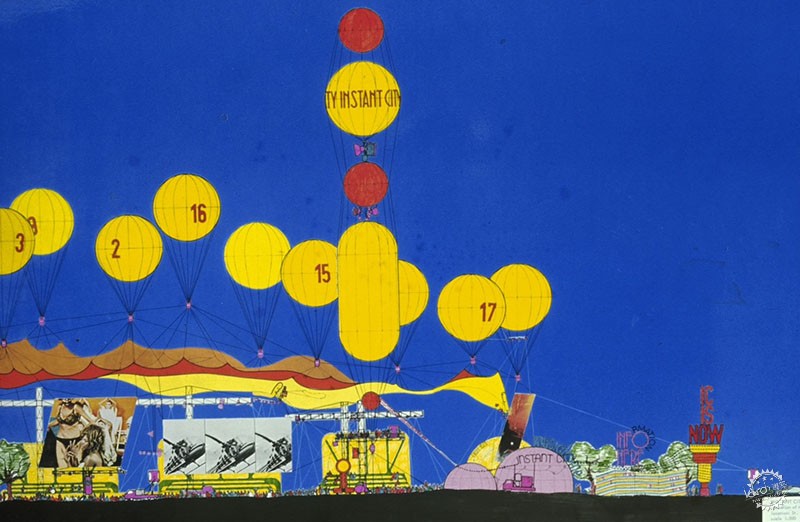
Image © Peter Cook
阿基格拉姆学派的涉猎范围广泛,他们从科幻小说、漫画、广告意象、波普艺术、诗歌元素中寻找灵感,将这些元素加入自己的设计作品中,该学派流行于一站之后的英国地区,他们坚持新未来主义原则、大众消费主义和现代技术。他们拒绝现代主义的束缚,构思设计出许多奇特的建筑作品,甚至开始构思具有强烈适应性的可移动城市,他们当时的思维比现代人甚至要先进许多。
Incorporating elements from science fiction, comics, advertising imagery, pop-art, poetry, and collage in their work, Archigram upheld the tenets of neo-futurism, mass-consumerism and contemporary technology in post-war Britain. They rejected the modernist straitjacket by spewing out fantastical designs of buildings and cities which were mobile, adaptable, and far more technologically advanced than anything that the modernists had built to that point.

Image Courtesy of Dario Bartolini (Archizoom Associati)
Archizoom Associati(意大利)
该团体最有名的理念则是不停歇的城市,以及他们折中主义的美学观念,这些概念在他们的设计作品Safari Chair和Dream Bed中很好地体现出来,这个意大利设计工作室通过讽刺、颠覆、嘲讽以及夸张的方式玩笑似地批判当前的社会现状。
在1961年的Superarchitettura展览中由Archizoom和Superstudio签署了联合宣言,他们宣称:“Superarchitettura的建筑作品是生产过剩、过度消费的产物。”这个离经叛道的团体善于使用雕塑的形式、明亮的色彩来表达对密斯椅的嘲笑,该团体主张彻底解放,以及“通过权力来反对现实,是缺乏行为举动的措施,也是对周边环境的破坏。”
Cavart(意大利)
该团体成立于1973年,“Cavart”意为“采石场” ,这个名字来源于该小组的第一个项目:位于Padua附近的Monte Lonzina采石场。该团体的活动范围主要位于距离城市较远的地区,主要活动形式是研讨会、表演和工作坊。最著名的是1975年为期一周的工作坊“Culturally Impossible Architecture”,参与者甚至超过了一百人,其中还不乏Will Alsop 和 Marco Zanini这样的人物。
Cavart孜孜不倦地致力于资产阶级的理想和美学研究,主张建筑与环境之间应当存在更有意义的关系。他们的工作坊经常在短短几天内就设计形成一个可移动式城镇,这些建筑都用生活中触手可及的普通材料建造而成。
Archizoom Associati (Italy)
Best-known for their No-Stop City and their eclectic, kitschy aesthetics that are best recognized in the design of the Safari Chair and the Dream Bed, this Italian design studio playfully critiqued the status-quo using satire, subversion, irony, and exaggeration.
In a joint manifesto signed for a 1961 exhibition Superarchitettura, by Archizoom and Superstudio, they proclaimed: “Superarchitettura is the architecture of superproduction, superconsumption, superinduction to consume, the supermarket, the superman, super gas.” Using sculptural forms, bright colors and “furniture-jokes” like the Mies Chair, the nonconformist group argued for total liberation from, and the “right to go against a reality that lacks meaning... to act, modify, form, and destroy the surrounding environment.”
Cavart (Italy)
Formed in 1973, “Cavart,” meaning “quarry,” was named after the site where the group’s first performance took place: the quarry of the Monte Lonzina near Padua. Often taking over such remote sites on the outskirts of cities, the group mainly operated through seminars, performances, and workshops. The most famous of all was the week-long workshop Culturally Impossible Architecture, which was home to over a hundred participants in 1975, including Will Alsop and Marco Zanini.
Cavart worked tirelessly to do away with bourgeoisie ideals and aesthetics, arguing for a more meaningful relationship between architecture and the environment. Their workshops often resulted in make-shift pop-up towns which were created from scratch in just a few days, with structures made with inexpensive, everyday materials which were easily accessible to all.
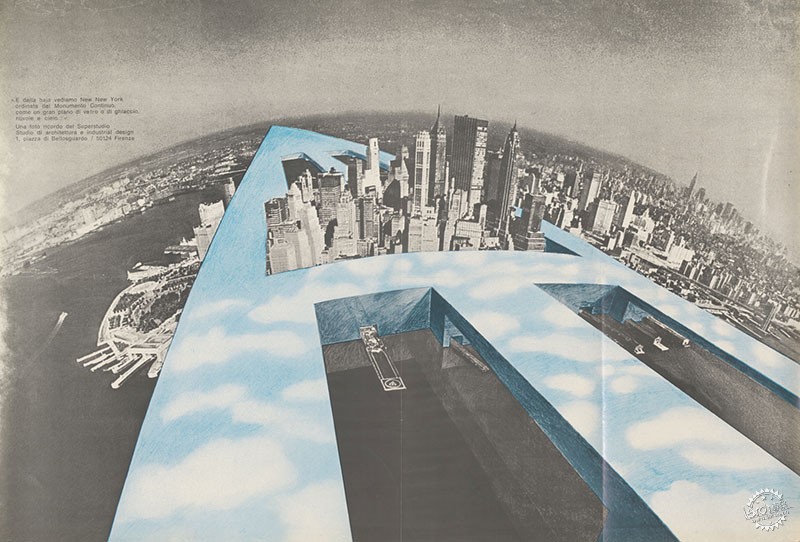
© Superstudio. Image Courtesy of Collection of the Alvin Boyarsky Archive
Superstudio(意大利佛罗伦萨)
Superstudio的激进设计理念在意大利史上空前的设计思潮,该团体运用了一系列的迷幻序列,其中有大量的黄金金字塔、可无限延伸的城市电网、漂浮着的金属舱体、巨大的反射立方体,还有以石头山为背景的人与巨型仙人掌的互动,所有这些奇特的景象都来自于Philip K Dick、Isaac Asimov以及J G Ballard,他们主要通过大胆的蒙太奇、插图、电影、展览和文本展示的手法来传达理念,该团体也在当时产生了及其深远的影响。
意大利设计团体UFO
难道所有激进的建筑团体并没有真正的建筑作品吗?事实并非如此,在上世纪60年代,有部分建筑团体仍然有进行空间设计,更特别的是,他们还设计过迪斯科舞厅或“管道空间”。意大利团体UFO决定将夜总会这个“中性空间”作为设计实验。他们从迪士尼漫画书《唐老鸭与魔法沙漏》中得到灵感,因此,这个设计团队设计了一个奇特的环境,这里充满了小时候沙漏形家具、大型灯笼以及飞毯上的DJ展台。当时,他们的设计作品展示了临时建筑和工业设备中独特的美学理念,在当时的世界上引起了一阵风靡。
Superstudio (Florence)
The bizarre imagery of Superstudio stands unparalleled in the history of the Radical Design Movement in Italy: a series of hallucinogenic sequences containing massive golden pyramids, city grids stretching towards infinity, metallic pods floating in space, gigantic reflective cubes parked in desolate landscapes, and humans mingling with giant cacti against a backdrop of rocky hills—all strangely reminiscent of the otherworldly visions of Philip K Dick, Isaac Asimov and J G Ballard. Through bold photomontages, illustrations, films, exhibitions and textual proclamations, their influence reached far and wide.
Gruppo UFO
Did all radical architecture groups, then, never actually “build buildings”? Not at all! A few did indeed dabble in (re)designing spaces, more specifically, discotheques or “pipers”, as they were locally known in the 60s. The Italian design group UFO decided to take control of this seemingly “neutral space,” the nightclub, as a ready canvas for experimentation. Taking inspiration from a Disney comic book, Donald Duck and the Magic Hourglass, the group created a strange setting replete with hour-glass shaped furniture, large lanterns and a DJ booth on a flying carpet. Makeshift structures and industrial aesthetics marked the experiments with discotheques in this era, all the while commenting on the sordid state of affairs in the world.
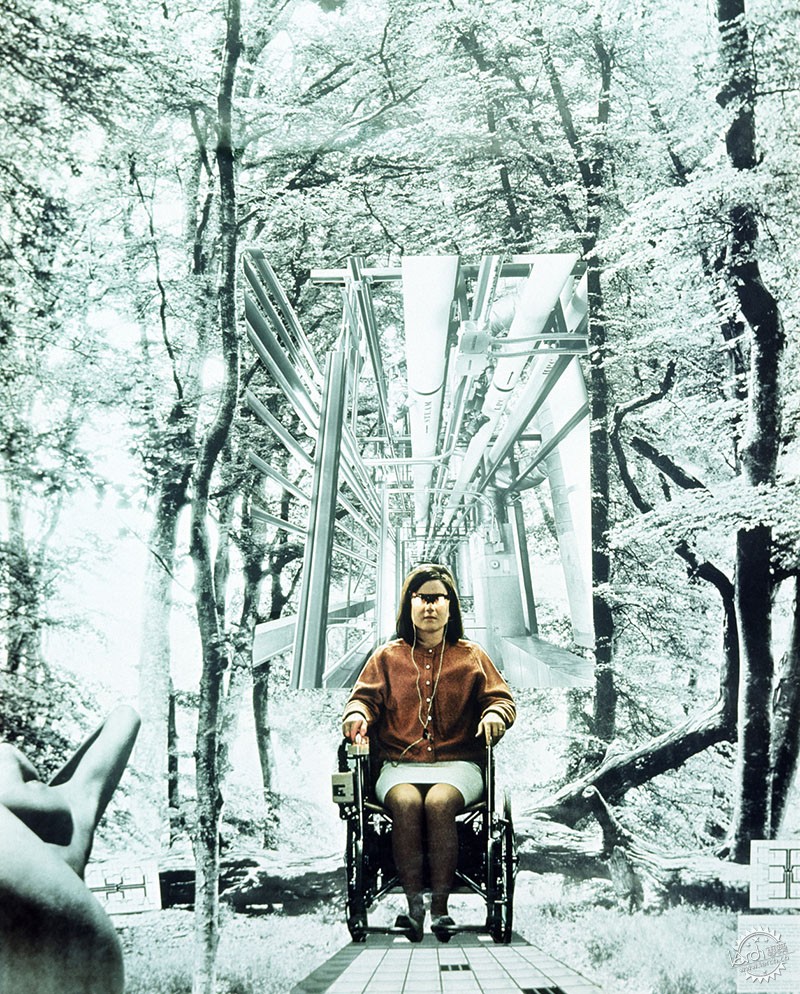
Image © Gruppo 9999
意大利设计团体9999
这个意大利团体9999成立于1967年,他们将一个发动机修理车间改造成为一个迪斯科舞厅,其中的家具由洗衣机桶和旧冰箱改造而成,它的名字叫做“Space Electronic”,白天,它是一所建筑学校,而到了夜晚则摇身变成夜总会。
9999团体也在他们的工作中体现了团员们对于可持续性发展以及生态关系的超前认识,在1971年的世界节日中,Space Electronic的一层被洪水淹没,而二层部分则形成了一片花园空间,这个花园只是一个试验作品,在1972年,9999团体获得了MoMA设计竞赛,该竞赛针对年轻设计师,该团体的设计作品蔬菜花园住宅获此殊荣。
意大利设计团体Strum
该团体成立于1971年,其成员由Giorgio Cerretti、Pietro Derossi、Carlo Gianmarco、Riccardo Rosso和Maurizio Vogliazzo。该团体的名字大致可以翻译为“工具建筑”,用以表示团队里的乐观精神。他们同样也以迪斯科舞厅作为试验作品,在项目中,团员们设计了有趣、适应性强的空间组合方案,即这是一个拥有时装、精品店、音乐以及舞蹈的空间。
Strum团队给人印象最深的作品是草绿色Pratone躺椅,这个作品常常为人们带来愉悦的心情,这个躺椅后来由意大利椅子制造商Gufram负责生产。
Gruppo 9999
In a similar vein, another Italian collective founded in 1967, Gruppo 9999, converted an engine repair workshop into a disco with furnishings made out of washing machine drums and old refrigerator cases, calling it Space Electronic—it became an architecture school by day and a nightclub by night.
Gruppo 9999’s work also brought to the fore their concerns about sustainability and ecology. In the 1971 Mondiale Festival, the second floor of Space Electronic sported a vegetable garden while the ground floor was flooded with water. This garden patch was just a precursor for what was to come—in 1972, Gruppo 9999 won MoMA’s Competition for Young Designers with the proposal for their Vegetable Garden House.
Gruppo Strum (Italy)
Founded in 1971, Gruppo Strum was Giorgio Cerretti, Pietro Derossi, Carlo Gianmarco, Riccardo Rosso and Maurizio Vogliazzo. The meaning of the name’s group roughly translates to “instrumental architecture”, indicative of the optimistic spirit that the group imbibed. Also experimenting with the discotheque format, they created playful, adaptable spaces with a mix of programs: a space for fashion shows and boutiques, music nights and dance.
Gruppo Strum is best remembered for its grass-green Pratone lounge chair, which, much to the delight of many, is back in production by Gufram, the Italian manufacturer of the original chair.
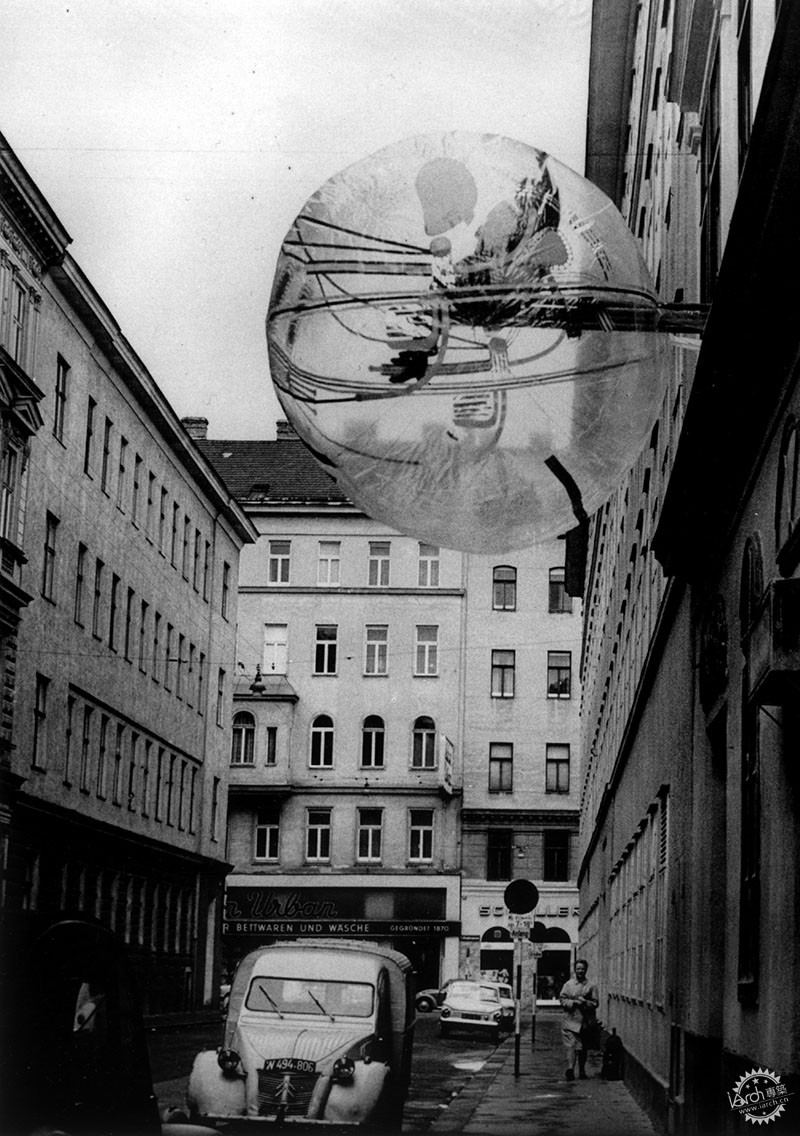
Image © Haus-Rucker-Co, Gerald Zugmann
Haus-Rucker-Co(维也纳)
这个维也纳的艺术团体的工作范围很广,包括建筑、心理学以及科技等方面内容,他们的设计作品不仅仅只有类似Oase Nr. 7的充气和寄生建筑,Oase Nr. 7是一个附加于现有建筑的球形气动结构,建筑师以此来创造出冥想或玩耍空间,另外,他们还设计由奇怪的呼吸头盔装置,例如Mind Expander系列。为了发挥人类的感知能力,这些头盔可以让戴着它们的人感受到奇特的新世界,增强了他们的感官触觉与嗅觉,从而改变他们对空间的看法。
Haus-Rucker-Co (Vienna)
This Viennese collective operating at the junction between architecture, psychology and technology is best remembered not just for its wild proposals for inflatables and parasitic architecture—like the Oase Nr. 7, a spherical pneumatic structure attached to an existing building during Documenta 5, creating a space for contemplation or play—but also the strange breathing devices and helmets like the Mind Expander series. Seeking to play with human perception, these helmets presented a bizarre new reality for those who wore them, heightening their senses and altering their ideas about space.
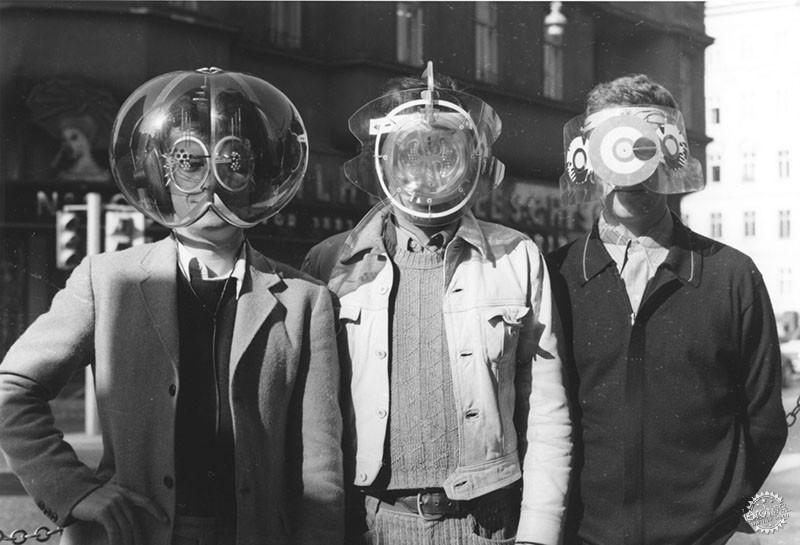
Image © Haus-Rucker-Co, Gerald Zugmann
该团体在他们的项目中运用了味觉作为设计出发点,他们的设计作品美食城I和美食城II甚至邀请旁观者完全吃掉他们的城市,事实上,这是一个可食用的明尼阿波利斯的部分模型,后来,他们还制作了波士顿以及中央公园的模型。
The group also employed the sense of taste in their projects: the notorious Food City I and Food City II invited onlookers to quite literally eat their city—an edible scale-model made of parts of Minneapolis, and later Houston, as well as Central Park.
出处:本文译自www.archdaily.com/,转载请注明出处。
|
|
